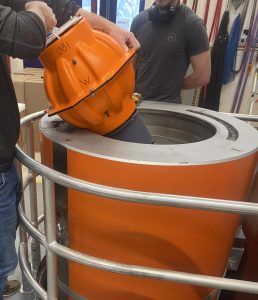 By Amy Bower
By Amy Bower
On the upcoming oceanographic expedition on R/V Roger Revelle, we will be releasing nearly 50 deep drifters in the Deep Western Boundary Current that snakes around the edge of the Grand Banks of Newfoundland and Flemish Cap (located southeast of the Canadian province of Newfoundland). This current is very deep, between 3000 meters and 4000 meters below the sea surface, and it flows close to the sea floor. To track its circuitous path around the bathymetric features in the region, we will release drifters called RAFOS floats, that will be tracked underwater using sound (more about that in a future post).
The floats must withstand the enormous pressures caused by the weight of the thousands of meters of water above them. To make sure they will go to the right depth, and that they are watertight under extreme pressure, we test them in the Hydrostatic Pressure Test Facility at Woods Hole Oceanographic Institution. This is a very large tank with thick walls and a heavy cover filled with water. The floats are put inside one or two at a time, the cover is locked in place, and a pump increases the pressure inside the tank to simulate conditions the floats will experience in the ocean. It takes about 20 minutes to build up the pressure inside the tank. While the pressure is building up, we measure the change in buoyancy of the float. Later, we use this information to add some weight to each float to make sure it will go down to exactly the depth of the Deep Western Boundary Current. Below are links to some “audio postcards” from one day when we were testing floats at the Hydrostatic Pressure Test Facility (HPTF).
> Anna talks with Heather at the HPTF
Click here to go to the list of all of our audio postcards, past and present.